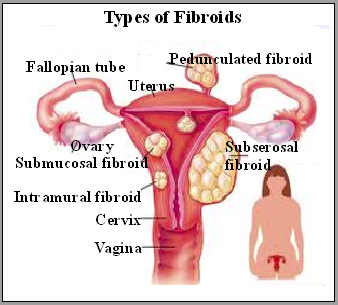Fibroid and Infertility: Most women incidentally discover the presence of uterine fibroid, especially when they present to their doctors for infertility investigations. The association of fibroids and infertility largely depend on the size, number and location of the fibroids. Fibroids can be located in the wall of the womb (intramural fibroids), on the external surface (subserosal) or in the cavity of the womb (submucous).
Submucosal fibroids seem to the most significantly associated with infertility and after fibroid resection (removal) pregnancy rates can increase by more than 50%. The presence of intramural fibroids can reduce the chance of an on-going pregnancy in assisted conception by up to 50%.
Treatment Treatment of fibroid can be done with an aim to remove the fibroid and/or relieve the associated symptoms and of course achieve the most desired for couples- have a family. Symptomatic uterine fibroids can be treated by a variety of modalities; for example, to treat the symptoms you can shrink, destroy or excise the fibroid. Anti-fibroid medications which are mostly hormonal preparations can be used to achieve this and include: progesterone, gonadotropin releasing hormone analogue and rarely RU-486). For pain relief simple analgesics (like paracetamol), non-steroidal anti-inflammatory drugs and occasionally stronger analgesics can be used with tremendous benefits.
Traditionally, fibroid surgery (myomectomy) with conservation of the womb especially in women seeking fertility treatments have been the mainstay of fibroid treatment. However, this comes with some complications like bleeding, infection, removal of the womb and even death in inexperienced hands. With advances in technology, the option to use less invasive means like laparoscopic and hysteroscopic surgical removal bring many advantages including shorter hospital stay, lesser pain relief requirements, small surgical incisions and therefore minimal scaring. On the contrary, these methods require expertise, expensive equipment (that is not widely available) and a longer procedure time. These key-hole surgical procedures are available and routinely done successfully and effectively in our Lekki centre in Lagos.
Other newer and non-invasive treatment options that are largely experimental and therefore not widely practiced include:
- percutaneous laser ablation
- cryoablation,
- transvaginal uterine artery occlusion
- magnetic resonance imaging (MRI)-guided focused ultrasound.
These treatment modalities are used in selected group of women. Significant proportions of women (sometimes with abnormally large symptomatic fibroids) unfavourably consider removal of the womb as a treatment modality even in those who have completed their families. Recent, conservative methods to avoid surgery such as uterine artery embolization (UAE) are now available to treat fibroid in few centres around the world. UAE, though relatively expensive and also not widely available, is the most significant therapeutic innovation for fibroids, however, it is not applicable in all cases, especially for women seeking fertility treatments. This is because of possible complications of loss of ovarian functions and decreased ovarian egg reserve that can compromise fertility. Other complications of UAE including pain, vaginal bleeding, and life threatening infections are also not uncommon.
Whereas fibroids are common and most easily diagnosed as such by physicians, careful and successful management depends on the type and aim of treatment and can be carefully personalized to each woman. This can only be successfully done by an expert gynecologist and it is noteworthy that minimal access (key-hole) surgery and successful treatments as day cases (without hospital admissions) are available in mine as well as some other clinics in Nigeria.
At Fertility Assyst we have an effective outpatient diagnostic and operative hysteroscopy/ laparoscopy services that reduces patients’ waiting times to fertility treatment access, provide continuity of service, a one-stop gynaecological / fertility treatment options that maximizes patients’ satisfaction. Fibroids should not ruin hopes to have children.
